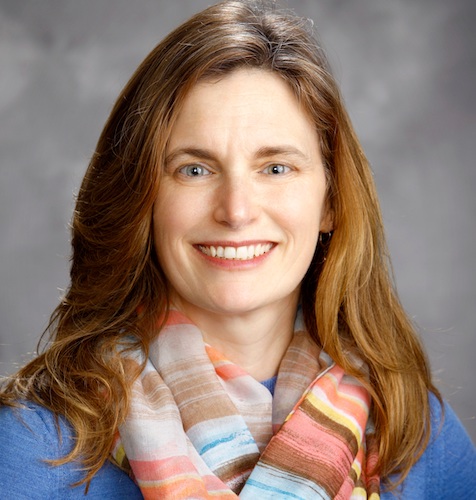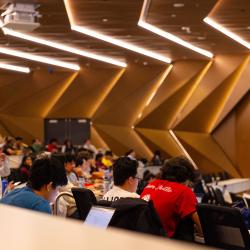Making Math a ‘Hero’
Alum Tamara “Tammy” Kolda (M.A. ’95, Ph.D. ’97, applied mathematics) leads a poster project to explain how math ‘saves the day’ and improves our daily lives.
When you think of mathematics, what comes to mind? Do you think of a recent internet shopping splurge, your last pizza delivery or today’s weather forecast? If you answered no, Tamara “Tammy” Kolda (M.A. ’95, Ph.D. ’97, applied mathematics) says you’re not alone. In her more than 20-year career as a mathematician, she found that all kinds of people—from decision-makers to educators and even math students—don’t realize how much advances in mathematics and statistics shape the world around us.

"Most people are not aware of the role of mathematics in their daily lives,” she explained.
Kolda hopes to change that. As a member of the National Academies’ Board on Mathematical Sciences and Analytics, Kolda chairs an all-star committee of mathematicians appointed to raise awareness about how pure and applied mathematical research paves the way for technological and engineering advances that make our lives better.
“The goal is to explain to the scientifically interested public where mathematics comes in,” Kolda explained. “You’d be surprised that even most math majors or statistics majors don’t know all the applications for math and statistics and what career avenues are available to them.”
Instead of lengthy reports or academic papers, Kolda and her committee took a more user-friendly approach to get their math message across: they created a series of posters. Each poster depicts a different aspect of the everyday impact of the mathematical sciences—from internet security to trip planning—and all of the posters are accessible online.
“We’re hoping people will print them and put them up at their institutions or carry them to meetings with their university leaders, for example, to explain what the math department does and the role of math in the larger scheme of science, business and technology,” Kolda explained. “I always thought of another target as people in Congress who are deciding how to allocate research funding, to explain why we still need to do research in mathematics.”
The path to math
For Kolda, who grew up in central Maryland, math has always been an important part of life. She still remembers the fun of summer math and computer camps that fed her interest in equations and problem-solving. Before she headed to college, she considered other options, but not for long.
“I originally thought I’d be a biologist, but I was quickly discouraged by the fact that I could not control things in experiments as precisely as I wanted to,” Kolda recalled. “I didn’t know exactly what I would do with math, but I decided it was something I wanted to pursue.”
After getting her undergraduate degree, Kolda went on to the University of Maryland to begin her graduate work and her path started coming into focus. Initially thinking she would focus on pure math, she soon discovered that applied math was what she really enjoyed, and she realized she was in exactly the right place at the right time.
“Maryland was a phenomenal experience, it was really the right place to go, there were so many professors I wanted to work with,” Kolda said. “I was particularly excited to meet Jim Yorke who I had heard of because he was featured in the book Chaos: Making a New Science by James Gleick. He was incredibly friendly and gracious, and I had the good fortune to do a reading course with him.”
Around that same time, the internet was just getting started and Kolda quickly found herself on a research path that combined optimization and linear algebra with high-performance computing, a field now known as data science. She worked with Professor Dianne O’Leary, a leading expert in computational science and numerical methods,. For Kolda, the research was as challenging as it was fascinating, and she was driven to succeed.
“I was definitely determined,” she explained. “It’s very hard to get a Ph.D., period. At that time, if you were a woman on top of that, you needed extra determination to make it. Honestly, I was so excited by mathematical research that don’t think anyone could have stopped me.”
From research to real-world experience
During her years at UMD, Kolda spent her summers doing internships that allowed her to apply her growing skillset to real-world situations, first at the National Security Agency in Ft. Meade, Maryland, and later at the Institute for Defense Analyses’ Center for Computing Sciences in Bowie, Maryland.
After earning her Ph.D. in 1997, she went on to do a postdoc at Oak Ridge National Laboratory, a Department of Energy facility in Tennessee, where she tackled problems in high-performance computing. That led to a position on the technical staff at Sandia National Laboratories in California, where she worked until 2021.
By then, she was ready for a change, so she started her own consulting firm called MathSci.ai.
“I wanted to see what would happen if I could do whatever I wanted,” Kolda recalled. “I have intellectual freedom to take on new challenges, working with new groups and it’s exciting.”
A visiting professor at Northwestern University since 2021, Kolda brings her scientific research experience in mathematical and computational data science to universities and research groups as well as nonprofits focused on public policy.
“My mission is to work on interesting problems to popularize new and emerging techniques that help with large-scale data analysis,” she explained. “I’m using techniques from different areas like theoretical computer science and high-performance computing, data analysis, and physics, and bringing these pieces together.”
“Math is almost everywhere”
The recipient of numerous awards and honors for her work, Kolda has served on the National Academies’ Board on Mathematical Sciences and Analytics since 2018. And when the board asked her to lead a project to raise awareness about the everyday impact of advances in mathematics and statistics, she jumped in with both feet.
“It just seemed like a good thing to invest time in, to broaden the world’s understanding of mathematics,” she recalled. “Math is almost everywhere, which almost makes it harder to see. This project was designed to educate the mathematical community, as well as the broader community on many of math’s different applications.”
Kolda and her committee
created posters to explain real-life math applications in every facet of our daily routines, such as how the mathematics of cryptography and signal processing keep us safe on the internet.
“One of the first posters we finished was The Mathematics of Internet Security,” she noted. “When you do a credit card transaction on the internet, there’s a lot of security behind it. When you browse the web and see https, that means it’s secure so no one can intercept what’s happening between you and your web server, and it’s all using mathematics.”
One of Kolda’s favorite posters is called Computed Commutes, the Mathematics of Getting from Here to There.
“There’s a lot of sophisticated mathematics that goes into mapping technologies and estimated time of arrival is part of that,” she explained. “It looks at things like traffic and mathematically predicts how long it’s going to be before you get there or how long it will take for a package delivery or even a pizza. It’s very statistically sophisticated.”
Another poster depicts Math as a comic book hero who saves the day in our everyday lives, a cartoon reminder that mathematics makes its mark in all kinds of ways.
“Artificial intelligence, image processing, satellite and medical images, weather forecasting and climate modeling, and many things in medicine are very mathematical and statistical as well,” Kolda noted. “Math is everywhere.”
Now that these new posters make it easy to see how advances in the mathematical sciences enhance our daily lives, Kolda hopes all kinds of people will get the message.
“For me, success would be seeing these posters plastered in every university and college throughout the U.S. and maybe even beyond that,” Kolda said. “I think it would help future mathematicians and statisticians get an idea of what opportunities are there for them and also help those who are funding mathematics programs understand why sending tax dollars to these purposes is so worthwhile. If we can accomplish that, I’ll be happy.”







